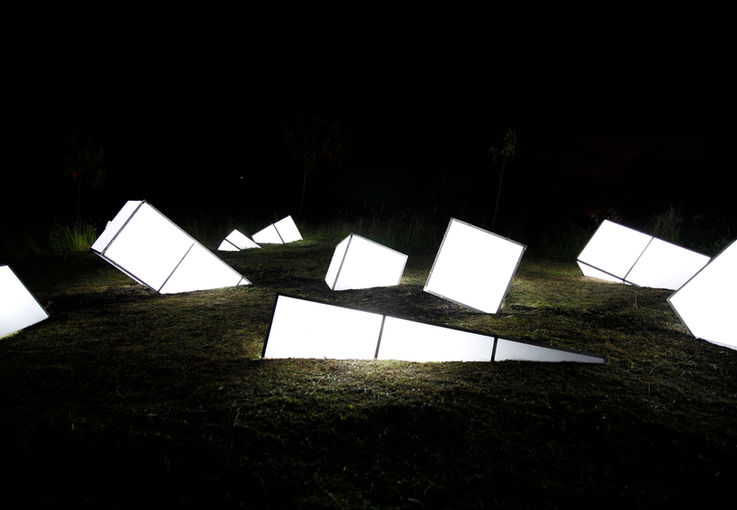run aground, intervenciones escultóricas, parte del proyecto visual some economies
Run Aground es un proyecto artístico que se presenta como un campo escultórico a cielo abierto, toca temas profundos sobre la frustración y la dificultad de establecer relaciones significativas con el mundo que nos rodea. Run Aground se conecta con el punto crítico entre contenedores, invernaderos y globalización, y cómo estos elementos convergen para resaltar desafíos cruciales en nuestra sociedad contemporánea.
Run Aground representa visualmente la frustración y la incapacidad de establecer relaciones auténticas con el mundo. Esta sensación de encallamiento y desconexión se asemeja al punto crítico en el que nos encontramos con la globalización, los contenedores y los invernaderos. Así como las esquinas flotantes de un contenedor se sienten encalladas antes de la inmersión total a la deriva, enfrentamos una sensación de encallamiento en el tejido complejo de la globalización.
Los contenedores, como metáfora de la interconexión global, reflejan la necesidad de mover bienes y productos en una economía globalizada. Sin embargo, esta interconexión conlleva una carga ambiental significativa, similar al impacto ambiental de los invernaderos. La necesidad de transporte a larga distancia para satisfacer la demanda global aumenta la huella de carbono, planteando una cuestión crucial señalada en Run Aground sobre la sostenibilidad y la preservación de nuestro entorno.
Run Aground menciona la idea del invernadero como una estructura que debilita la biodiversidad. Esto resuena con la expansión desenfrenada de los invernaderos en respuesta a la demanda global de alimentos fuera de temporada. Aunque los invernaderos son una solución para la seguridad alimentaria, su uso excesivo puede tener un impacto negativo en el equilibrio ecológico y la biodiversidad.
El punto crítico entre estos elementos ilustra la complejidad de nuestros desafíos contemporáneos. La globalización ha brindado beneficios económicos pero a expensas del medio ambiente y la equidad social, problemáticas que Run Aground intenta destacar al representar la frustración y la desconexión. La necesidad de abordar estos problemas de manera sostenible y equitativa es urgente, reflejando la esencia misma de Run Aground al plantear preguntas sobre nuestra relación con el mundo y la imperfección de nuestras estructuras.
Run Aground plantea preguntas cruciales sobre nuestra interacción con el mundo en el contexto de la globalización, los contenedores y los invernaderos. Representa visualmente la frustración y la desconexión que enfrentamos en un mundo interconectado pero desafiante. Al analizar este proyecto a la luz del punto crítico entre contenedores, invernaderos y globalización, emerge la necesidad de abordar de manera equitativa y sostenible los desafíos ambientales y sociales inherentes a nuestra era globalizada.
Run Aground is an artistic project that is presented as a sculptural field in the open air. It touches on deep subjects such as frustration and the difficulty to establish significant relationships with the world around us. Run Aground connects with the critical tension point between containers, greenhouses and globalization, and how these elements converge to highlight crucial challenges in our contemporary society.
Run Aground visually represents the frustration and the incapacity to establish authentic relations with the world. This sensation of being stranded and disconnected is similar to the critical point in which we find ourselves in relation to globalization, containers and greenhouses. Just like the floating corners of a container feel stranded before being completely immersed, drifting in open seas, we face the sensation of being stranded in the complex fabric of globalization.
The container, as a metaphor for global interconnection, reflects the need to move goods and products in a globalized economy. However, this interconnection entails a significant environmental burden, similar to the environmental impact of greenhouses. The need for long distance transportation to satisfy global demand increases the carbon footprint, this proposes a crucial matter made visible in Run Aground about sustainability and the preservation of our environment.
Run Aground mentions the idea of a greenhouse as a structure that weakens biodiversity. This resonates with the unbridled expansion of greenhouses in response to the global demand for foods that are out of season.
Even though greenhouses are a solution towards food security, their excessive use can have a negative impact on the ecological balance and the biodiversity of the planet.
The critical point between these elements illustrates the complexity of our contemporary challenges. Globalization has offered financial benefits but at the expense of the environment and social equality as well, conflicts that Run Aground tries to highlight by representing frustration and disconnection.
The need to solve these issues in a fair and sustainable manner is urgent, reflecting the very essence of Run Aground poses questions about our relationships with the world and the imperfection of our structures.
Run Aground asks crucial questions about our interaction with the world in the context of globalization, the containers and the greenhouses. It shows the frustration and disconnection that we face in an interconnected, but challenging world. When we analyze this project focusing in the critical point between containers, greenhouses and globalization, there comes the need to talk, in a fair and sustainable way, about the environmental and social challenges inherent to this globalized era.













